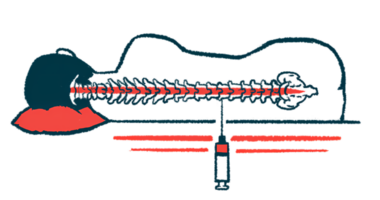#ACTRIMS2022 – Spinal Cord Atrophy Predicts ‘Silent Progression’ in Early MS

A faster rate of atrophy in the spinal cord of people in earlier stages of multiple sclerosis (MS) is likely to indicate “silent progression” — worsening disability in the absence of relapses — and a swifter conversion to secondary progressive MS (SPMS), new data show.
Antje Bischof, MD, with University Hospital Munster in Germany, shared these findings at the Americas Committee for Treatment and Research in Multiple Sclerosis (ACTRIMS) Forum 2022. Her presentation was titled “Spinal Cord Atrophy Predicts Silent Progression in Relapse-onset Multiple Sclerosis.”
MS for most people is characterized by relapses — times when new symptoms appear or old symptoms suddenly worsen — followed by remissions where symptoms ease. Relapses are often associated with a worsening in disability, although in some cases disability worsens without a relapse.
“We know that there are some patients who, very early on in the disease, already demonstrate disability worsening [in the absence of relapses]. That is called ‘silent progression,'” Bischof said.
“These patients obviously need more aggressive treatment, and therefore it is very important to develop predictive biomarkers to be able to stratify these patients early on to more aggressive treatments,” she added.
Atrophy or degeneration in the spinal cord is strongly correlated with disability severity in MS. It also helps discriminate patients with relapsing-remitting disease (RRMS) from those who progress to SPMS.
“We thought it would be important to look into whether spinal cord atrophy would be a predictor of progression” in MS, Bischoff said.
Data analyzed covered 360 MS patients, as well as 80 matched controls without the autoimmune disorder, who were followed for 12 years. Most participants were female, with an average age in the early 40s.
At the study’s start, all MS patients had RRMS in relatively earlier stages; the median disease duration was about five years. After 12 years, 54 of these patients had been documented as progressing to SPMS.
Researchers evaluated spinal cord atrophy by analyzing patients’ annual MRI brain scans, which were taken throughout the study. Spinal cord damage was basically assessed by looking at damage in the bottom-most area of brain images, essentially showing the top of the spinal cord.
Their analyses looked for associations between spinal cord atrophy and silent progression, defined as a worsening of disability (as measured by the expanded disability status scale or EDSS) in the absence of relapses that was sustained for at least one year.
Silent progression was evident in 159 of the MS patients after an average of about 3.3 years in the study — which is “quite early” in the disease’s progression, Bischof said. She noted that patients with silent progression had significantly lower median EDSS scores at the study’s start that those who did not (scores of 1.5 vs. 2), indicating these people tended to start with less severe disability.
Among patients who did not experience silent progression, the average rate of spinal cord atrophy was 0.54% per year. Among those with silent progression, the rate of spinal cord atrophy was about 1.5 times faster: 0.84% per year.
Further analyses showed that, for each 1% increase in the rate of spinal cord atrophy, the average time to disability progression shortened by 69%.
“The faster the [spinal cord] atrophy rate is, the shorter becomes the time to [disability] progression,” Bischof said.
Similar results were found in predicting RRMS progression to SPMS: patients who converted had a faster average rate of spinal cord atrophy (2.19% vs. 0.88% per year), and a 1% faster atrophy rate was associated with a 53% shorter time to SPMS conversion.
Patients with silent progression also had a larger rate of ventricular enlargement (3.57% vs. 3.12%), referring to an increase in the size of fluid-filled spaces (ventricles) in the brain. This association is “probably a proxy of brain atrophy,” Bischof said.
No association was seen between spinal cord atrophy and relapse rates, treatments, or lesions.
Spinal cord atrophy “is the strongest indicator of silent progression and SPMS conversion,” Bischof concluded.
She noted that these findings underscore that RRMS and SPMS are a continuum of disease states, rather than two separate entities. In fact, the RRMS patients who had experienced silent progression should probably have been classified as having SPMS, which is defined mainly by worsening disability in the absence of relapses.
Inconsistency in labeling exists “because the clinician and the patients also did not notice that they actually clinically progressed,” Bischof said, highlighting just how “silent” this type of progression can be.
Editor’s note: The Multiple Sclerosis News Today team is providing in-depth coverage of the ACTRIMS Forum 2022 Feb. 24–26. Go here to see the latest stories from the conference.






